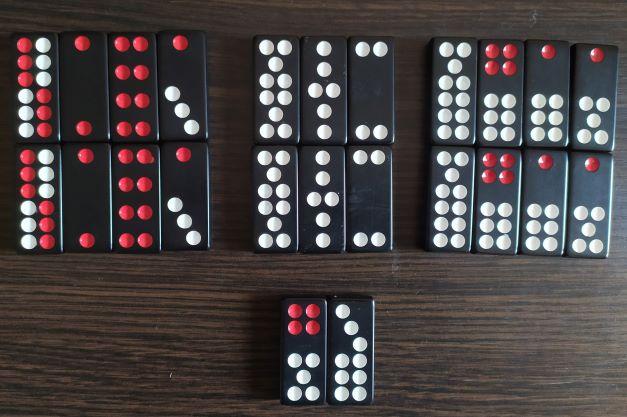Folk Tien Gow
When I looked for videos of people playing Tien Gow, I often saw people playing differently than the classic rules, with quite different play options. The basic mechanics remained the same, but there were some differences. I call these games “Folk Tien Gow” because people simply refer to it as “Tien Gow”, even though it’s different to classical rules.
If you haven’t read the classic Tien Gow rules article , please do so before continuing.
A smaller deck
Folk Tien Gow is often played with a reduced domino set of 24 tiles. Less often - with 30.
If there are 30 tiles, then the “supreme pair” ([4:2] and [2:1]) is removed from the deck.
If there are 24 tiles, there are different options:
- All civilians and nines from the military ([6:3][5:4])
- All civilians and a supreme pair ([4:2] and [2:1])
- All civilians except [5:1] plus military nines and supreme pair ([6:3],[5:4],[4:2] and [2:1])
In the first version of 24 tiles, the pair of nines plays the role of “supreme pair” because it does not beat anything and cannot be beaten.

Example of a Folk Tien Gow deck
Number of players
Often four people play, but one player always rests in turn, that is, there are only three active players. Or only three players play, without a fourth resting one. I also saw four active players with the 24 tiles deck, but then each player will receive only six tiles.
Combinations
Since there are not enough military tiles in a set of 24 tiles, there are no mixed combinations, only pure pairs. But two combinations of three tiles are added: [1:1][2:2][3:3] and [4:4][5:5][6:6]. The second beats the first, nothing beats the second.
Bidding
Sometimes there is a bidding round after the deal. The players declare whether they will play or not. If no one wants to play, then there is a redeal. If the applicant is alone, then he immediately wins. If there are more applicants, then the game is played and the settlement is made only between the players who have declared the game.
Bidding is not done in turn, but simply by laying out the domino tiles face down and then revealing them at the same time.
Unfortunately, I did not understand the principle of bidding and which tile means what. I suspect that one of the top four civilian tiles means “play” and the rest “don’t play”. It is possible that players who declared a “game” and lost pay more than those who “passed”. Unfortunately, I was only able to glean information about this game from a video and from one not fully understood answer from a Chinese forum (given on a separate page. However see Mo Hua Hua description for more information.
Victory and calculation
Taking the last trick is not the most important thing in all options. Sometimes they just look at the number of tricks.
The calculation in the folk version is often simplified. For example all losers give a winner one chip. Also, I read about an option where all tricks are worth one point, and the last one is worth five. The calculation takes place accordingly.
I would like to note that the calculation in the game for three with 30 tiles or four with 24 tiles cannot be done classically, since the total number of tricks is 10 or 6, respectively (and not 8, so one cannot calculate tricks “below 4”).
Mo Hua Hua
Since I have reconstructed the above rules from videos and some obscure sources, I could have made a mistake. However there is one game, rules of which are also not entirely clear, but still can help us with understanding the Folk Tien Gow rules. Even though it is played with paper dominoes, it’s pretty similar and we can use it to clear up some obscure moments. I’m talking about game Mo Hua Hua, which I recommend reading about next.
Video sources:
- https://www.ixigua.com/6692629485155516935
- https://www.ixigua.com/6808288260763157007
- https://www.ixigua.com/6746167153143054855
- https://v.youku.com/v_show/id_XMzk2ODU0ODUxMg==.html